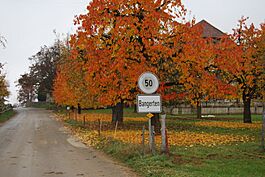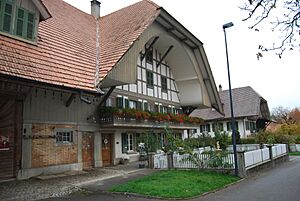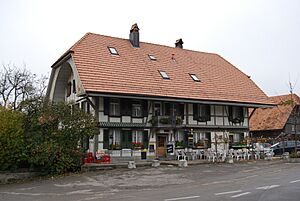Bangerten facts for kids
Quick facts for kids
Bangerten
|
||
|---|---|---|

Entrance to Bangerten village
|
||
|
||
| Country | Switzerland | |
| Canton | Bern | |
| District | Seeland | |
| Area | ||
| • Total | 2.2 km2 (0.8 sq mi) | |
| Elevation | 586 m (1,923 ft) | |
| Population
(Dec 2014)
|
||
| • Total | 151 | |
| • Density | 68.6/km2 (178/sq mi) | |
| Postal code |
3256
|
|
| Surrounded by | Iffwil, Rapperswil, Scheunen, Zuzwil | |
Bangerten was once a small town, or municipality, in Switzerland. It was located in the Seeland area of the canton of Bern. On January 1, 2016, Bangerten became part of the nearby town of Rapperswil.
Contents
History of Bangerten
Bangerten was first mentioned in old writings in 1263. Back then, it was called Bongarthen. People have even found Roman coins here, showing that people lived in this area a very long time ago.
In the 1200s and 1300s, a group called the Order of St. John bought most of the land in Bangerten. Later, in 1528, when monasteries (religious communities) were no longer controlled by the church, Bangerten became part of a local government area called the Landvogtei of Münchenbuchsee.
For a long time, Bangerten was mostly a farming community. In 1990, many of the people working in the village were farmers. Because it was a small place, Bangerten shared some services with its neighbors. For example, it shared a primary school with Scheunen and a secondary school with Rapperswil.
Geography of Bangerten
Bangerten covered an area of about 2.2 square kilometers (0.85 square miles).
- Most of this land, about 62%, was used for farming.
- About 32% of the land was covered by forests.
- The remaining 6.4% was used for buildings and roads.
The village included the main settlement of Bangerten, a smaller area called Hohrain, and several scattered farms. Since 1940, Bangerten has been part of the church community of Rapperswil. The village has had its own cemetery since 1924.
Bangerten's Coat of Arms
The design of Bangerten's coat of arms shows a red shield. From a green base, a green apple tree with golden apples grows. Behind the tree is a golden woven fence.
People of Bangerten (Demographics)
In 2014, Bangerten had a population of 151 people. In 2010, about 4.4% of the people living there were from other countries.
Most people in Bangerten speak German. In 2000, about 93.7% of the population spoke German as their main language. A few people also spoke French or Arabic.
In 2008, the population was almost evenly split between males (48.7%) and females (51.3%). About 19% of the population were children and teenagers (0–19 years old) in 2010. Adults (20–64 years old) made up about 69.6%, and seniors (over 64 years old) were about 11.4%.
The chart below shows how the population of Bangerten has changed over many years:

Interesting Places to See
The whole village of Bangerten is recognized as an important Swiss heritage site. This means it has special historical and cultural value.
Economy and Jobs
In 2011, the unemployment rate in Bangerten was low, at 1.87%. In 2008, there were 38 people working in the municipality.
- Most jobs were in the primary economic sector, which means farming. There were 27 people working in agriculture.
- Only 1 person worked in the secondary sector, which includes things like manufacturing.
- 10 people worked in the tertiary sector, which includes services like shops and restaurants.
Many people who lived in Bangerten traveled to other towns for work. In 2000, 63 people left Bangerten to work elsewhere, while only 8 people came into Bangerten for work. About 16.5% of workers used public transportation, and 47.4% drove their own cars.
Religion in Bangerten
Based on information from 2000:
- About 5.1% of the people were Roman Catholic.
- About 81.0% belonged to the Swiss Reformed Church (a type of Protestant church).
- A small number of people belonged to other Christian churches or were Islamic.
- About 10.76% of the population did not belong to any church, or were agnostic (not sure about God) or atheist (do not believe in God).
Education in Bangerten
In Bangerten, about 40.5% of the people had finished upper secondary education (like high school). About 20.9% had gone on to higher education, such as university.
During the 2010–11 school year, no students were attending school directly in Bangerten. However, 13 students from Bangerten went to schools in other towns in 2000.
See also
 In Spanish: Bangerten para niños
In Spanish: Bangerten para niños








